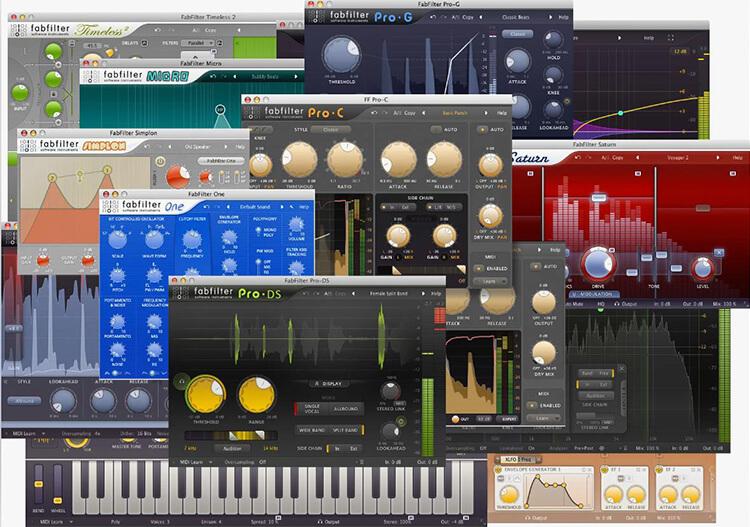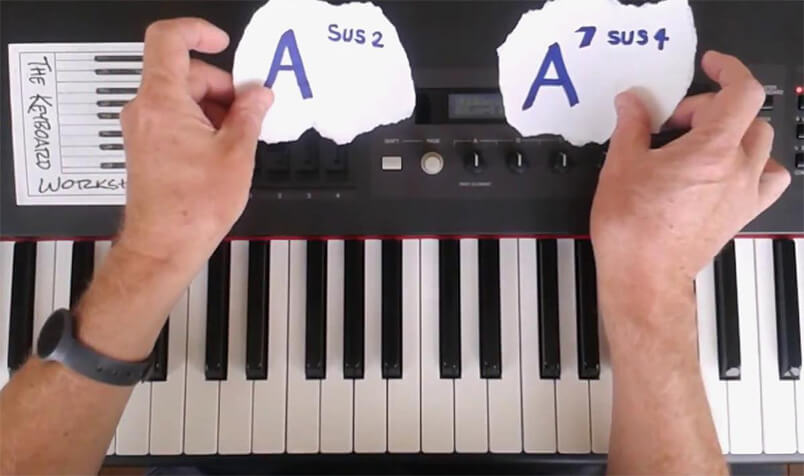Lydian dominant scale
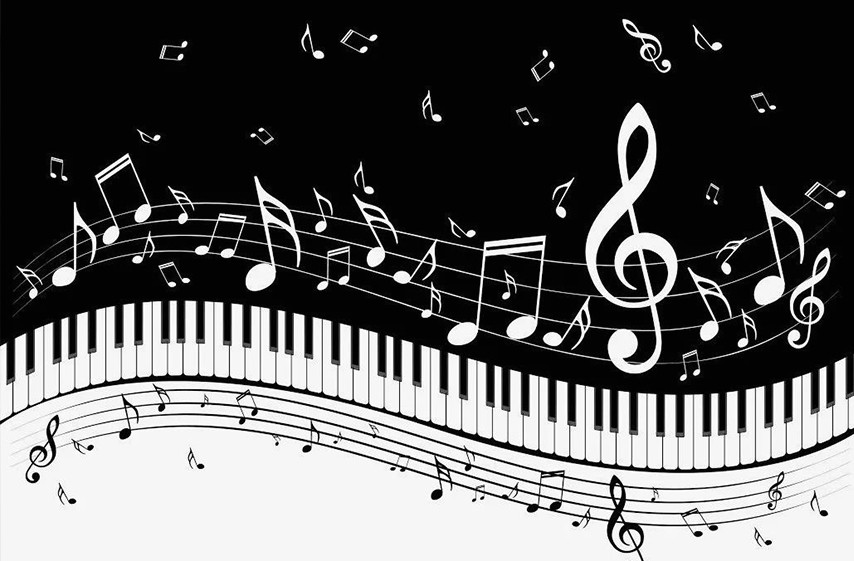
The Lydian mode stands out among the major modes for its unique use of the augmented interval. In this article, we’ll cover everything you need to know about the Lydian mode and why it’s one of the most sought-after modes in Western music theory.
The term “Lydian Dominant” may be unfamiliar and even a little intimidating, but don’t worry. Chances are you’re already familiar with this magical sound, even if you’ve never known its name. This special raised-4 dominant chord sound (#11) can be heard in many jazz, R&B, and gospel songs.
The following example demonstrates one way you can hear this distinctive Lydian Dominant sound.
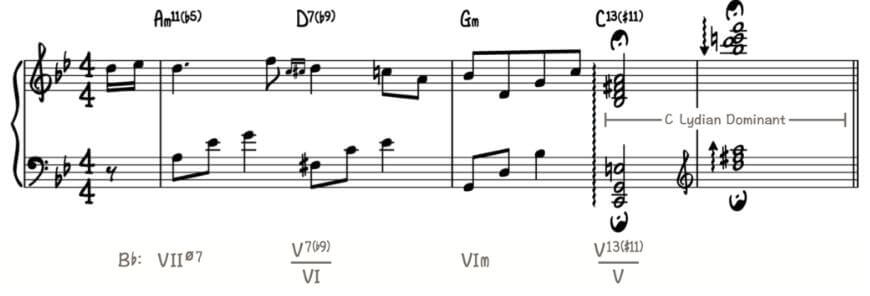
What a captivating tone! In this lesson, you will learn how to convey this magical sound both melodically and harmonically. The lesson materials in PDF format and backing tracks can be downloaded at the bottom of this page after logging in with your membership. In addition, you can easily transpose the lesson examples to any key using our Smart Sheet Music.
What are modes?
Before we dive into the Lydian mode, it is important to understand the concept of modes or modal scales.
What are modes or modal scales?
Modes are the seven diatonic scales found in Western music, each with a unique sound. They are all based on the major scale, which contains five whole and two half steps, but they start on different notes, which is what gives them their distinctive characteristics.
For example, if you play a C major scale, it would look like this:
C-D-E-F-G-A-B
However, if we start the same sequence of notes from D, we get the following scale:
D-E-F-G-A-B-C
This is the Dorian mode on the note D.
If you start with the note F, then this will be the Lydian mode on the note F:
F-G-A-B-C-D-E
Below are all the modal scales based on the major scale:
- Ionian mode C: C-D-E-F-G-A-B;
- Dorian mode D: D-E-F-G-A-B-C;
- Phrygian mode E: E-F-G-A-B-C-D;
- Lydian mode F: F-G-A-B-C-D-E;
- Mixolydian mode G: G-A-B-C-D-E-F;
- Aeolian mode A: A-B-C-D-E-F-G;
- Locrian mode B: B-C-D-E-F-G-A.
What is the Lydian Dominant Scale?
The Lydian Dominant scale is a 7-note scale often used in jazz, R&B, and gospel music that combines elements of the Lydian and Mixolydian modes. The formula for this scale is 1–2–3–♯4–5–6–♭7. So the C Lydian Dominant Scale has the notes C–D–E–F♯–G–A–B♭. The interval pattern of the scale is W–W–W–H–W–H–W (where W is a whole step and H is a half step). Other common names include the Mixolydian #11 Scale, Lydian ♭7 Scale, and the 4th mode melodic minor.
C-Lydian Dominant Scale

The name “Lydian Dominant” reflects both the tonal characteristics and the harmonic function of this particular jazz scale. Harmonically, it sounds like a dominant, meaning that the 1st, 3rd, 5th, and 7th degrees of the scale form a dominant seventh chord, such as C-E-G-B♭. The word “Lydian” here is an adjective, indicating the presence of a raised 4th degree (or ♯4), which is a characteristic feature of the traditional Lydian scale. The raised 4th is also known as a ♯11, since when the scale notes are superimposed in thirds, this note is an 11th interval above the root. In other words, the 11th degree is simply the 4th raised an octave. In the case of the C Lydian Dominant scale, ♯4 or ♯11 is the note F♯.
The examples below will help you hear and visualize how the C Lydian Dominant scale combines the tonal characteristics of the Lydian and Dominant modes.
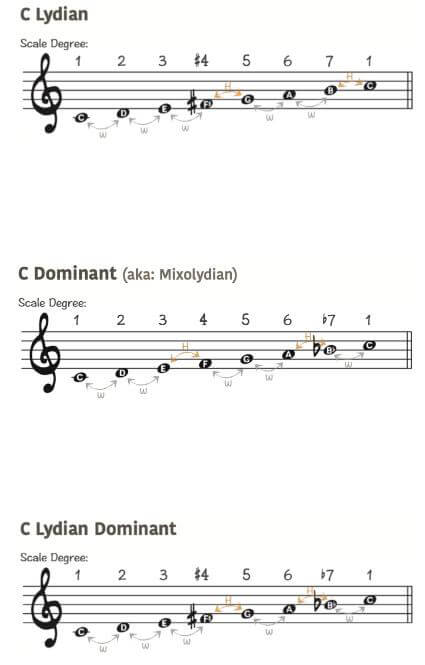
You can compare this scale to the Phrygian Dominant scale, which also has dominant characteristics but is tonally similar to the Phrygian mode.
Other Names for the Lydian Dominant Scale
Like many jazz scales, the Lydian Dominant scale is known by a variety of names among musicians. Here are a few you should know.
#1: Mixolydian Mode #11

Many jazz musicians call this scale Mixolydian ♯11 or Mixolydian ♯4. This is because it differs from the standard Mixolydian mode by only one note – ♯4 or ♯11. The examples below will help you hear and visually recognize these similarities.

#2: Lydian ♭7 Scale
Another common name for this scale is the Lydian ♭7 Scale. This name emphasizes that this scale differs from the classic Lydian scale by only one note: ♭7. In the examples below, you will be able to hear and see these similarities.
#3: Melodic Minor 4th Mode
You may be wondering, “How did the Lydian Dominant scale come about?” You may have noticed that this scale has both sharps (♯) and flats (♭). This is no coincidence. In fact, this scale is one of the modes of the melodic minor (ascending version). If you play any melodic minor scale starting from its 4th degree, you get the Lydian Dominant scale. The following examples will help you hear and visualize the C Lydian Dominant as the 4th mode of the G melodic minor.

Now that you know how this special jazz scale is built, let’s look at which chord symbols will tell you when to use it.
Chord Symbols for the Lydian Dominant Scale
There are three chord symbols that signal when the Lydian Dominant scale can be used: Dominant 7 (♯11), Dominant 9 (♯11), and Dominant 13 (♯11). For example, if you see chords marked C7 (♯11), C9 (♯11), or C13 (♯11), the C Lydian Dominant scale is ideal for improvising. The examples below show how to play each of these chords on the piano.

Note that the C13(♯11) chord is often formed using the Upper Structure Triad (UST) technique, where the right hand plays a D major triad and the left hand plays the root notes of a C7 chord. Since the root of the upper triad is a major second degree above the root of the root chord, this technique can be labeled UST Ⅱ, where UST stands for Upper Structure Triad. UST can be played in any inversion, but for best sound, the hands should be no more than an octave apart.
Triads in the Lydian Dominant Scale
Let’s take a minute to look at the types of triads found in the Lydian Dominant Scale. This will give us an idea of the chord qualities that are created when a triad is built on each note in the scale. Using the C Lydian Dominant scale as an example, you will see the following diatonic triads: major (Ⅰ), major (Ⅱ), diminished (Ⅲº), diminished (Ⅳº), minor (Ⅴm), minor (Ⅵm), and augmented (Ⅶ+).

This information is useful because there is a popular jazz improvisation technique known as the “triad pair,” which uses adjacent diatonic triads to create interesting solo lines. Later in this lesson, we will arpeggio successive C Lydian Dominant triads to linearly extend the ♯11 dominant sound within a phrase.
When to Use the Lydian Dominant Scale
Now that you know how to construct Lydian Dominant scales and chords, it is also important to understand the harmonic contexts in which this sound is most often used. Typically, this sound is used when a dominant chord symbol with a ♯11 appears in a notation, but chord notations are not always that precise. In this section, we will look at four jazz chord progressions that are particularly suited to using the Lydian Dominant sound.
Four Jazz Chord Progressions with the Lydian Dominant
Here are four jazz chord progressions that use the Lydian dominant scale:
- Ⅰ▵7 → Ⅱ7 (Major seventh on the tonic, followed by a dominant seventh on the second degree);
- Ⅰ▵7 → Ⅳ7 (Major seventh on the tonic, followed by a dominant seventh on the fourth degree);
- Ⅰ▵7 → ♭Ⅶ7 (Major seventh on the tonic, followed by a dominant seventh on the flatted seventh);
- Final chord Ⅰ7 (Jazz melodies that end on a dominant seventh chord).
Four Lydian Dominant Progressions in C Major
Now let’s look at these four jazz progressions in the key of C major:
- Ⅰ▵7 → Ⅱ7 = C▵7 → D7;
- Ⅰ▵7 → Ⅳ7 = C▵7 → F7;
- Ⅰ▵7 → ♭Ⅶ7 = C▵7 → B♭7;
- Final chord Ⅰ7 = C7.
Four Lydian Dominant Progressions with a Transposed C7(♯11)
In the next section, we’ll look at jazz improvisational techniques for each of these four typical Lydian dominant chord progressions. But you may have noticed that the progressions above involve four different dominant seventh chords (D7, F7, B♭7, and C7). The easiest way to start practicing with the Lydian dominant is to transpose each progression so that the dominant seventh chord is always C7. So we’ll practice each progression in the following keys:
- Ⅰ▵7 → Ⅱ7 in B♭ major = B♭▵7 → C7;
- Ⅰ▵7 → Ⅳ7 in G major = G▵7 → C7;
- Ⅰ▵7 → ♭Ⅶ7 in D major = D▵7 → C7;
- Final chord Ⅰ7 in C major = C7.
If you are a PWJ member, please note that the three backing tracks in the Lesson Resources section at the bottom of this page correspond to the first three keys in the list above. The last example with the final chord C7 does not require a backing track.
Now we are ready to improvise with the C Lydian Dominant scale!
Jazz Phrases Using the Lydian Dominant Scale
In this section, we’ll look at four jazz soloing techniques using the Lydian Dominant scale. Remember, our C7(#11) scale runs C–D–E–F♯–G–A–B♭. The four improvisation approaches we’ll look at are:
Scalar Approach
- Arpeggiated Chords;
- Motif Lines;
- Triadic Approach;
- Scalar Approach.
First, let’s listen and try to improvise with the Lydian Dominant Scale using the scalar approach. This example illustrates the sound of straight eighth notes.

#2: Arpeggiated Chords
Now let’s try improvising jazz licks based on the Lydian dominant scale using arpeggiated chords or chord contours. This example, like the others, conveys the rhythm of a swinging eighth note.

#3: Motive Lines
Now let’s try to improvise using motive lines based on the Lydian dominant scale. A motive is a short musical idea that is repeated.

#4: Triadic Approach
Finally, we’ll use a triadic approach to create a linear extension of the Lydian dominant sound on the final dominant seventh chord. This technique creates an airy effect similar to the soft cymbal drumming at the end of a melody.

How to Use the Lydian Mode in Music
Now that you understand what the Lydian mode is, let’s discuss some ways to use this unique mode in your music.
Writing a Song Using the Lydian Mode
One of the simplest ways to use the Lydian mode in a song is to replace the 4th note of a major scale with a raised version, giving the song a new feel.
Consider the F major scale, which includes the notes:
F-G-A-Bb-C-D-E
If you start with the note F and use the rest of the notes around it, treating F as the “home” note, you get a standard major scale. However, if you start with the note Bb:
Bb-C-D-E-F-G-A
and treat Bb as the “home” note, the melody takes on a new flavor that is different from the major. Try pressing the Bb pedal and playing the rest of the notes of the Lydian scale to get a feel for its smooth, whimsical tone.
Adding an Accent with the Lydian Mode
Sometimes, when playing a major or minor scale, you can use modes to add a unique accent to the melody. This is called a modal swap.
For example, if we are playing in D major:
D-E-F#-G-A-B-C#
and want to introduce a Lydian mode, say D Lydian, we need to find which scale starts on the 4th degree. For D Lydian, this would be A major:
A-B-C#-D-E-F#-G#
D Lydian uses the same notes as A major, but the scale starts on D:
D-E-F#-G#-A-B-C#
The main difference between D Lydian and D major is the raised 4th degree (G# instead of G). This accent can add an interesting flavor to a major composition.
Conclusion
We hope this quick guide to the Lydian mode will inspire you to try new things in music. Music theory doesn’t have to be complicated or confusing if you follow a clear outline.
The Lydian mode is one of our favorite ways to add unique melodies and chord progressions. It can give your music an airy, light sound. But don’t forget that there are other modes besides the Lydian, each offering unique creative possibilities.


